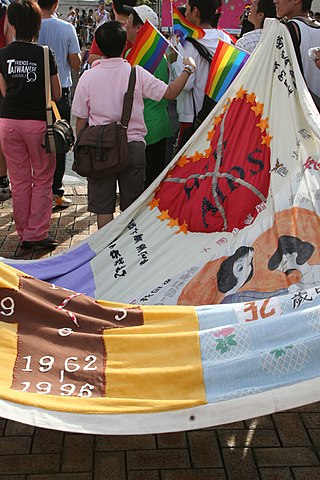History

The first Australian case occurred in 1981: the patient was a 72 year old man who died in September that year. However the case was only diagnosed retrospectively in 1994. [2]
Until then, the first reported case was a 27 year old New York resident on a working holiday, who was diagnosed in Sydney in October 1982. [3]
In May 1983, Sixty Minutes, a then highly-popular television current affairs programme that was broadcast on a national free network, Channel 9, featured a 15 minute report The AIDS Mystery. As the first significant media account in the country, the programme's large audience reach caused it to have wide impact. [4]
The first reported death in Australia from HIV/AIDS was reported in Melbourne in July 1983. [5] [6] [7]
Spurred to action both by the emergence of the disease amongst their social networks and by public hysteria and vilification, gay, lesbian, drug user and sex worker communities and organisations were instrumental in the rapid creation of AIDS councils (though their names varied), sex worker organisations, drug user organisations and positive people's groups. The AIDS councils were formed in South Australia, Victoria and Western Australia in 1983, and in New South Wales, Queensland, Tasmania and the Australian Capital Territory in 1985. [5] [8] [9] [10] [11]
The state and territory AIDS councils, along with the other national peak organisations representing at-risk groups Australian Injecting & Illicit Drug Users League (AIVL), National Association of People with HIV Australia (NAPWHA), Anwernekenhe National Aboriginal and Torres Strait Islander HIV/AIDS Alliance (ANA), the Scarlet Alliance, and the Australian Federation of AIDS Organisations (AFAO), all contribute to Australia's response to HIV. [12]
Non-governmental organisations formed swiftly and have remained prominent in addressing AIDS in Australia. The most notable include the AIDS Trust of Australia, formed in 1987, [13] The Victorian AIDS Council (VAC), [14] formed in July 1983, and the Bobby Goldsmith Foundation, founded in mid 1984. The Bobby Goldsmith Foundation is one of Australia's oldest HIV/AIDS charities. [15] The Foundation is named in honour of Bobby Goldsmith, one of Australia's early victims of the disease, who was an athlete and active gay community member, who won 17 medals in swimming at the first Gay Olympics, in San Francisco in 1982. [16] The Foundation had its origins in a network of friends who organised care for Goldsmith to allow him to live independently during his illness, until his death in June 1984. This approach to supporting care and independent living in the community is the basis of the Foundation's work, but is also an approach reflected in the activities and priorities of many HIV/AIDS organisations in Australia.
In 1985, Eve van Grafhorst was ostracised since she had contracted HIV/AIDS caused by a transfusion of infected blood. [17] The family moved to New Zealand, where she died at the age of 11.
HIV/AIDS in Australia since 2000
While the spread of the disease has been limited with some success, HIV/AIDS continues to present challenges in Australia. The Bobby Goldsmith Foundation reports that nearly a third of people with HIV/AIDS in New South Wales (the state with the largest infected population) are living below the poverty line. [15] Living with HIV/AIDS is associated with significant changes in employment and accommodation circumstances. [18] [19]
Survival time for people with HIV has improved over time, in part through the introduction of antiretroviral drug treatments [20] with post-exposure prophylaxis treatments reducing the possibility of seroconversion and minimising the likelihood of HIV progression to AIDS. However, HIV does have its own health issues. [21] [22]
After the initial success in limiting the spread of HIV, infection rates began to rise again in Australia, though they remained low by global standards. After dropping to 656 new reported cases in 2000, the rate rose to 930 in 2005. [23] Transmission continued to be predominantly through sexual contact between men, in contrast to many high-prevalence countries in which it was increasingly spread through heterosexual sex. [23] [24] Indeed, the majority of new Australian cases of HIV/AIDS resulting from heterosexual contact have arisen through contact with a partner from a high-prevalence country (particularly from sub-Saharan Africa or parts of south-east Asia). [25]
The new trend toward an increase in HIV infections prompted the government to indicate it was considering a return to highly visible advertising. [26] Reflecting this concern with the rise in new cases, Australia's fifth National HIV/AIDS Strategy (for the period 2005–2008) was titled Revitalising Australia's Response, and placed an emphasis on education and the prevention of transmission. [27]
On 19 October 2010, The Sydney Morning Herald reported that 21,171 Australians have HIV, with 1,050 new cases diagnosed in 2009. The Sydney Morning Herald also reported that 63% of Australians living with HIV were men who have sex with men (MSM), and 3% were injecting drug users. [28]
In 2016, the Australian government and AFAO announced that AIDS was no longer a public health crisis given the decline in numbers of new cases and the availability of treatment. [29]










